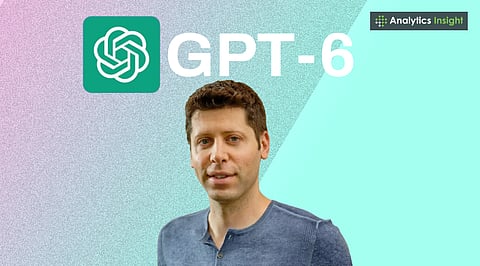

Sam Altman is preparing GPT-6 with personalization, memory, and ethical safeguards after GPT-5’s rocky reception.
OpenAI shifts focus to a companion-like AI as GPT-6 aims to fix GPT-5’s flaws with adaptive memory and tone.
GPT-6 promises faster release, customization, and privacy safeguards, marking Altman’s bold vision for the future of AI.
OpenAI’s CEO, Sam Altman, has already planned for the next ChatGPT model, GPT-6. Within days of releasing the latest GPT-5, the CEO of the company has started planning the next phase of generative AI development.
While users have been getting accustomed to GPT-5, and the criticisms regarding this LLM haven’t yet been pacified, GPT-6 is already in discussion. The launch of GPT-5 was kind of disastrous. Millions of users have complained that this GPT model provides a less personalized experience than previous models.
However, accepting all, Altman is now shifting toward an approach where AI will be more like a companion than a mere tool. He promises to bring a deeply personalized model with memory, adaptability, and ethical responsibility for GPT-6.
According to Altman, memory will be the defining feature of the upcoming GPT model. About this, he stated, “People want memory, People want product features that require us to be able to understand them.” The AI will remember preferences, habits, and other details over multiple sessions, marking a departure from the traditional one-off interactions.
While talking about the memory advancement, he called it his “favorite feature of 2025.” This hints at a shift toward a user-friendly experience that evolves with time. Aside from this, GPT-6 will feature improved customization. What this means is that the tone of the AI tool will change based on user preferences. This will be a grand comeback covering the most criticized feature of GPT-5, its robotic tone.
OpenAI is working on release speed, too. According to the CEO, ChatGPT-6 is expected to arrive earlier than GPT-5. This strategy is likely aimed at regaining user trust more quickly with a more thoughtfully designed LLM model.
Also Read: Top ChatGPT Rank Tracker Tools in 2025
In the evolving Artificial Intelligence era, developing an AI that truly understands user preferences is a significant challenge. It comes with several complications, and the chief among them includes vulnerability and privacy concerns. Altman is aware that a model with memory can be dangerous.
While it can offer customization, it brings a different issue as well. If the data aren’t handled responsibly, it can cause serious issues. He has acknowledged that the current memory feature lacks encryption. Maybe stronger safeguards will arrive later, but there’s no timeline stated at this point.
The balance goes beyond encryption. The rocky reception of GPT-5 has taught the company a lot. The OpenAI CEO mentioned that the company is aiming to build a more personalized system that won’t exploit vulnerable user data, but will become a personal assistant.
For Altman, GPT-6 is more than just an assistant. It’s a tool that adapts others’ worldview without reinforcing destructive thinking. He emphasizes that customizing the upcoming model won’t lead to any adverse effects. This will be especially helpful for those who are a little weak mentally.
Altman has a high ambition for the upcoming ChatGPT model. He is trying to make this model a utility platform, integrally blended into the daily lives of people.
Also Read: ChatGPT Go: The Cheapest Subscription Available Here
Sam Altman’s vision for GPT-6 is bold and progressive. He aims to develop an AI model that bridges the gap between humans and AI by leveraging memory, customization, and emotional compatibility. He seeks to rectify the shortcomings of GPT-5 and provide users with a more personalized experience.
This ambition is impressive, but it comes with privacy concerns and possibilities of ethical boundary exploitation. So, OpenAI must ensure that memory doesn’t become surveillance for users. If the AI giant can execute this vision without compromising the privacy of the users, it will set a benchmark for others.
At this point, it’s challenging to predict what the GPT-6 launch will truly deliver, but there’s a significant likelihood of disappointing users with overpromises and underdelivery.
1. What new memory features will GPT-6 have compared to previous versions?
Ans: GPT-6 will introduce persistent, context-aware long-term memory, letting AI recall user preferences, habits, and conversations for tailored, human-like assistance, aiming to build trust and reduce repetition while boosting personalized user engagement.
2. How will personalization in GPT-6 work, and can users shape tone and chatbot personality?
Ans: Personalization in GPT-6 enables users to influence chatbot tone, style, and responsiveness, allowing creation of assistants that adapt to unique preferences and routines, moving beyond generic interaction toward true individualization and increased emotional consistency.
3. What is Sam Altman's stance on privacy and encryption for GPT-6 user data?
Ans: Sam Altman acknowledges that persistent memory raises privacy concerns; future GPT-6 versions may include stronger encryption, user controls, and transparent policies for sensitive data, focusing heavily on robust security and ethical handling of personalized information.
4. When is the expected release date for GPT-6 according to Sam Altman?
Ans: While no launch date is confirmed, Altman hints GPT-6 development is accelerated compared to previous models. Industry speculation suggests release may be less than six months away, driven by rapid progress following GPT-5’s controversial rollout.
5. How will GPT-6 address criticisms of GPT-5 and improve user experience?
Ans: GPT-6 aims to address GPT-5 criticisms by enhancing warmth, memory and personalization, making AI less distant and more consistent, with improvements in conversation flow, context retention, and user satisfaction at the forefront of new feature development.
